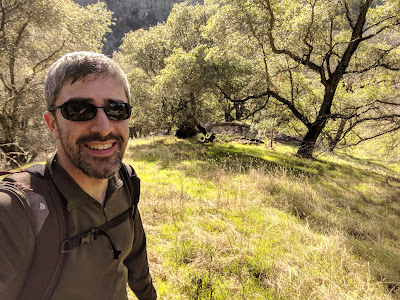This weekend was the January VHF contest, and I was eager to participate. I decided I could kill two birds with one stone by operating from a SOTA summit. The first challenge was finding a suitable summit. I was looking for a peak with good line of sight to the Bay Area and Central Valley, and one that didn't have any towers on the summit. I've found that the best VHF summits already have towers on top, and there is generally too much RF for my radios. Eventually I decided on Loma Alta in Marin County.
 |
| View down Lucas Valley, from near the trailhead. San Pedro Mtn to the right of center. |
This summit is bare on top, except for a fence to keep the cows in the correct pasture. I was, however, concerned that
Mt Tam would block my signals to the south and I wouldn't be able to reach anyone on the peninsula. It turns out the map in my head was slightly off, and I had clear views of San Francisco and points south. The areas blocked by
Mt Tam are sparsely populated.
 |
| Mt Diablo and North Peak is the double summit on the left. |
I decided to hike up from the Big Rock Trailhead,
unlike last time. My impression was that this trail is less steep and a more pleasant hike. This could be because last time I hiked up in the mid afternoon in June, and it was very hot then. The trail to the top is part of the Bay Area Ridge Trail, and crosses an easement. The rancher passed me a few times riding up and down on his four-wheeler. When I got near the top, the wind really started to pick up, and didn't relent until I descended later.
 |
| Almost at the top. |
At the summit I wasted no time in putting on warmer clothes and jackets. Having done this, I began to set up my antennas. I had my trusty doublet for 6m, an Arrow 2/70 satellite antenna for 2m and 70cm, and a new Arrow yagi for 220. I had ordered a Ukrainian transverter for 220, but it didn't arrive in time (and hasn't arrived at the time of writing). I brought up both of my fishing poles. I used the shorter, thinner one to hold up the doublet, strapping it to the fence.
 |
| Setup, looking to the north-east. Big Rock Ridge on the left. Maybe Berryessa Peak in the center? |
I guyed out my other pole, then had to figure out how to attach the yagis. I had one mounting bracket, but the pole was to skinny except at the bottom section to attach it, so I used it for the 220 antenna. I only had to disassemble the yagi twice in order to get the bracket on the pole and in the proper polarisation. For the 2/70 yagi, I used some giant twist-ties I got from REI. This works, but is not a good solution. In June, I'll have more mounting brackets. Somehow, one of the element-center screws had gotten lost, so I only had a 6 element yagi on 70.
 |
| Mid afternoon, some cows came over to say hi. |
By the time I had finished putting up the antennas and connecting all the rigs and transverters, it was 10:57. Just enough time to rest for a moment before the contest started. I had assumed that there would be a lot of activity on 6 meters, but I didn't hear anyone there at the start. It turns out that 2m sideband was the place to be. After moving up, I began making contacts. For the next five hours I switched modes and bands, trying to get as many contacts as I could.
 |
| Sunset, just before starting my hike down. |
In the end I made 75 contacts with 15 multipliers for a
claimed score of 1425. My antennas almost blew over once, but I was able to catch the mast and avoid any catasrophies. Partway through I decided to take a break from all the SSB, so I went down to 30 meters and put out a spot. This brought in contacts at a faster rate than in the contest, at least for a few minutes. At the UTC day rollover I decided that I was getting cold and I wanted to be down before dark, so I went QRT and packed up.
 |
| The big rock at the trailhead. |
I was surprised to pass a few groups heading up so late in the day. After dropping below the ridge, the wind was dramatically reduced, and I began to warm up quickly. At home, I started the tedious process of typing in all the contacts so I could submit my score. Overall, I think the contest went well for me. Next time I think I will try to find a mountain with a better view of the central valley. I also hope to have one antenna and feedline per band, as it will make QSYing much easier. I will also fix the mounting brackets so I can use them higher up on the mast.
Trailhead: Big Rock Trailhead, height of land on Lucas Valley Road.
Website: SOTA Site
Maps: AA6XA SOTA Hikes map
Route: Take the trail to the summit. There is only one from this side, and all junctions are onto private land, and clearly signed.
Red Tape: Stay on the trail, it passes through an easement.
 |
| Sunset is the best time to be outside in California. Mt Diablo in the distance. |




















































